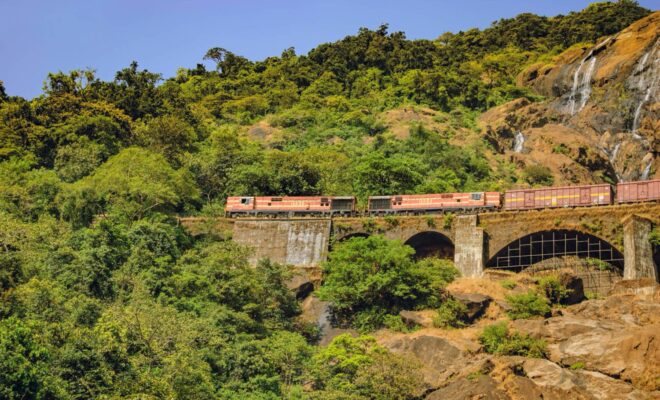India
Google Project Showcases Indian Railways’ 165-Year Journey

Train on the railroad bridge in the background of Dudhsagar waterfall in Goa.
Photo: Bigstock
The Google Art and Culture project chronicles the 165-year history of Indian Railways, showcasing the unsung heroes, the extraordinary engineering, and the scenic railway tracks and destinations.
The glorious story of Indian Railways, along with narratives of the unsung heroes and the extraordinary engineering feats that have resulted in the vast railway tracks and scenic stations, has come alive online through a Google project.
The 165-year journey of Indian Railways, showcased in the Google Art and Culture project, includes numerous picturesque views of the tracks and destinations, as also the stories of people who keep the humongous network running.
The online exhibition, organized in collaboration with Indian Railways under an online project called “The Railways: Lifeline of a Nation,” will also be exhibited at 22 stations in the country, including New Delhi, Bengaluru, Coimbatore, Guwahati and Howrah.
This two-year digitization project was launched on Sept.28 at the National Rail Museum in New Delhi.
Travel through the history of Indian Railways on @googlearts. Explore scenic routes and local destinations, and read heart-warming stories of @RailMinIndia‘s legacy.
→ https://t.co/vNp2Qo3M1K pic.twitter.com/fqZxBG4jZX— Google India (@GoogleIndia) September 28, 2018
The project is going to be an experience for the “1.3 billion people of India about what the 1.3 million railway employees are doing for serving them,” Railways Minister Piyush Goyal said at the launch event, IANS reported.
“From the Nilgiri mountains to the Chhatrapati Shivaji Terminus Station, let the people of India relive their childhood… through the train journey to Madhira and through the Darjeeling toy train; let’s show them the Kangra Valley, the Kalka-Shimla experience so that it could be enjoyed by someone in Coimbatore or Ooty,” Goyal added.
The project will showcase photographs, documentaries, texts, virtual tours, 360-degree videos, and maps to give people an in-depth exploration of different aspects of the Indian Railways. The exhibition, which can be accessed for free, shows scenic views of the Heritage Bridge on the Kalka-Shimla route, the Calcutta tram and the pristine stations such as Coonoor and Darjeeling, among others.
The visual and textual narratives are divided into various sections, such as Journeys, People, Heritage and Engineering. It features untold stories about the workforce behind these wheels on tracks, such as the first female member of Indian Railway Service of Signal Engineers, M. Kalavathy, and the first woman officer in the Railway Protection Force, Jaya Chauhan. Ganey Khawas, 102, is the oldest living former worker of the Darjeeling Himalayan Railway, and remembers the days of the steam engines.
India saw its first passenger train on April 16, 1853, which covered a distance of 34 km from Bombay (now Mumbai) to Thane, carrying 400 people. The network of railway tracks today covers 151,000 km in the country.




You must be logged in to post a comment Login